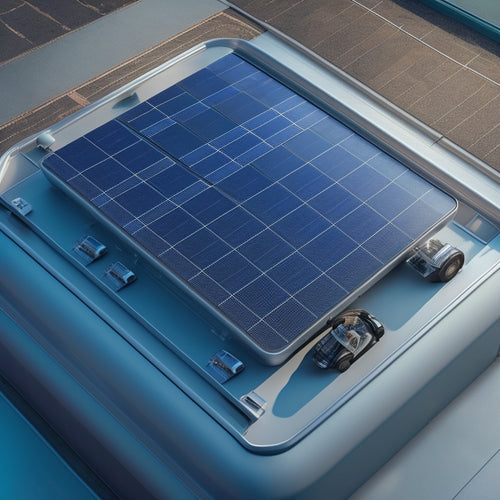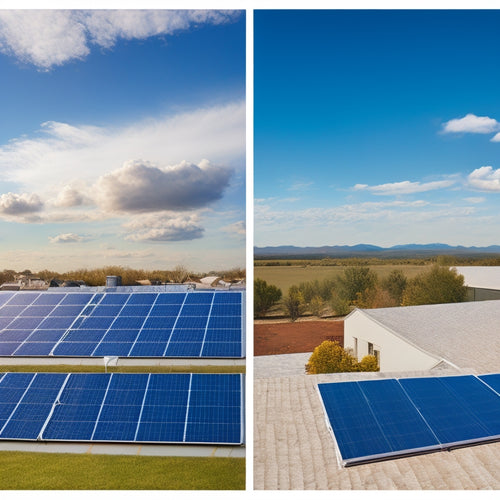
Essential Steps for PV Panel Installation
Share
You'll need to complete five essential steps for a successful PV panel installation. First, assess your site's solar potential by evaluating orientation, shading, and unobstructed sunlight. Next, choose a compatible PV system considering panel efficiency, temperature coefficient, and power output. Prepare the installation site by conducting a site orientation assessment, clearing roof debris, and securing necessary permits. Then, install PV panels and mounts, ensuring proper orientation, secure fastening, and compliance with local building codes. Finally, connect to the grid safely by complying with electrical codes, installing a certified grid-tie inverter, and thoroughly testing the system - and that's just the beginning of ensuring a safe and efficient installation.
Key Takeaways
- Assess solar potential by evaluating orientation, shading, and obstructions to ensure optimal energy output.
- Choose the right PV system by considering panel efficiency, temperature coefficient, and compatibility with existing infrastructure.
- Prepare the installation site by clearing debris, verifying structural integrity, and securing necessary permits.
- Install PV panels and mounts securely, ensuring proper orientation, tilt, and compliance with local building codes.
- Connect to the grid safely by installing certified grid-tie inverters, ensuring proper grounding and bonding, and conducting thorough testing.
Assessing Your Site's Solar Potential
At least 90% of a successful PV panel installation depends on evaluating your site's solar potential accurately. You can't just assume your location is suitable for solar energy generation without doing your due diligence. You need to assess your site's solar potential to guarantee maximum energy output.
Start by evaluating your site's orientation. A south-facing roof or open space is ideal, as it receives direct sunlight for most of the day. If your site has an east-west orientation, you'll need to adjust your panel installation accordingly.
Next, conduct a shading analysis to identify any obstacles that might block sunlight, such as trees, buildings, or chimneys. You'll need to trim or remove these obstacles to guarantee your panels receive unobstructed sunlight. You can use specialized software or consult with a professional to perform a detailed shading analysis.
Choosing the Right PV System
You've assessed your site's solar potential, and now it's time to select a PV system that matches your energy needs and budget. When choosing the right PV system, you need to contemplate system compatibility, ensuring that all components work seamlessly together. This includes inverters, mounting systems, and monitoring equipment.
Next, evaluate panel efficiency, which affects the system's overall performance. Higher efficiency panels may be more expensive, but they can generate more power per unit area. You should also take into consideration the panel's temperature coefficient, which indicates how well it performs in high temperatures.
Additionally, think about the system's power output, factoring in your energy requirements and the available roof space. A larger system may not always be the best option, as it may not be compatible with your existing electrical infrastructure.
Preparing the Installation Site
Your rooftop is about to experience a conversion, becoming a hub of clean energy production. Before the installation begins, you need to prepare the site to guarantee a successful and efficient process.
To get started, you'll need to:
-
Conduct a site orientation assessment to determine the ideal placement of your PV panels, considering factors like roof pitch, direction, and surrounding structures.
-
Perform a shade analysis to identify any obstructions that may impact energy production, such as trees, buildings, or chimneys.
-
Clear the roof of debris, such as leaves or branches, to provide a clean working surface.
-
Confirm the roof is structurally sound and can support the weight of the PV system.
-
Verify that all necessary permits and approvals are in place before commencing the installation.
Installing PV Panels and Mounts
As the preparation phase comes to a close, it's time to focus on the core component of your solar panel system: the panels themselves. Now, you'll install the PV panels and mounts, guaranteeing ideal energy production.
When installing panels, consider the orientation. Ideal panel orientation varies by location, but generally, a south-facing orientation with a tilt between 30° and 40° is recommended. This maximizes energy output during peak sun hours.
You'll also need to choose the right mount type for your system. Common mount types include:
| Mount Type | Description |
|---|---|
| Roof-Mounted | Attached directly to your roof |
| Ground-Mounted | Installed on the ground |
| Tracking Mount | Moves to follow the sun's path |
| Building-Integrated | Integrated into the building's structure |
| Pole-Mounted | Raised on a pole |
Select a mount type that suits your installation site and local building codes. Confirm the mounts are securely fastened to the roof or ground to withstand environmental factors like wind and snow. Proper installation of PV panels and mounts is essential for a safe and efficient solar panel system.
Connecting to the Grid Safely
Most residential solar panel systems are connected to the electrical grid, allowing you to offset your energy consumption and even sell excess power back to the utility company.
When connecting to the grid, it's essential to guarantee your system meets the necessary safety compliance measures and grid interconnection requirements.
To achieve a safe and compliant grid connection, you'll need to:
- Comply with local electrical codes and regulations, such as the National Electric Code (NEC) in the US
- Install a grid-tie inverter that meets the utility company's requirements and is certified for grid connection
- Verify your system is properly grounded and bonded to prevent electrical shock
- Install a utility-interactive meter to measure the energy you produce and feed back into the grid
- Perform thorough testing and commissioning to confirm your system is operating safely and efficiently
Frequently Asked Questions
How Often Should I Clean My PV Panels to Maintain Efficiency?
"When it rains, it pours" - but not on your PV panels, which require regular cleaning to maintain efficiency. You should clean your panels every 6-12 months, depending on climate and pollution, to guarantee ideal panel maintenance and maximize energy harvesting.
Can I Install PV Panels on a Metal or Clay Tile Roof?
You can install PV panels on a metal or clay tile roof, but you'll need to choose installation techniques that ascertain roof compatibility, such as using specialized mounting systems or consulting with a professional to assure a secure and efficient setup.
What Happens to Excess Energy Generated by My PV System?
As you utilize the power of the sun, you're left wondering: what happens to excess energy generated by your PV system? You'll be thrilled to uncover that with net metering benefits, you can feed it back into the grid, and with battery storage options, you can store it for later use.
Are PV Panels Durable Enough to Withstand Extreme Weather?
You're right to wonder if your PV panels can handle extreme weather; fortunately, they're built to last, with rigorous testing ensuring their panel resilience can withstand harsh weather impacts, such as heavy snow loads and intense hail storms.
Can I Expand My PV System in the Future if Needed?
You'll have a million reasons to upgrade your energy needs in the future, but don't worry, you can easily expand your PV system if needed, as long as you've planned your system capacity wisely during installation, allowing for seamless upgrades down the line.
Related Posts
-

Top Solar Panels for Car Battery Maintenance
When selecting top solar panels for car battery maintenance, consider high-efficiency models with high wattage output...
-

Top Online Stores for Solar Car Accessories
When searching online for solar car accessories, you'll find top retailers like Amazon, REI Co-op, and Best Buy offer...
-

Tracking Solar Panels Vs Fixed Panels Cost Savings
When considering solar panel options, you'll want to weigh the cost savings of tracking solar panels versus fixed pan...


